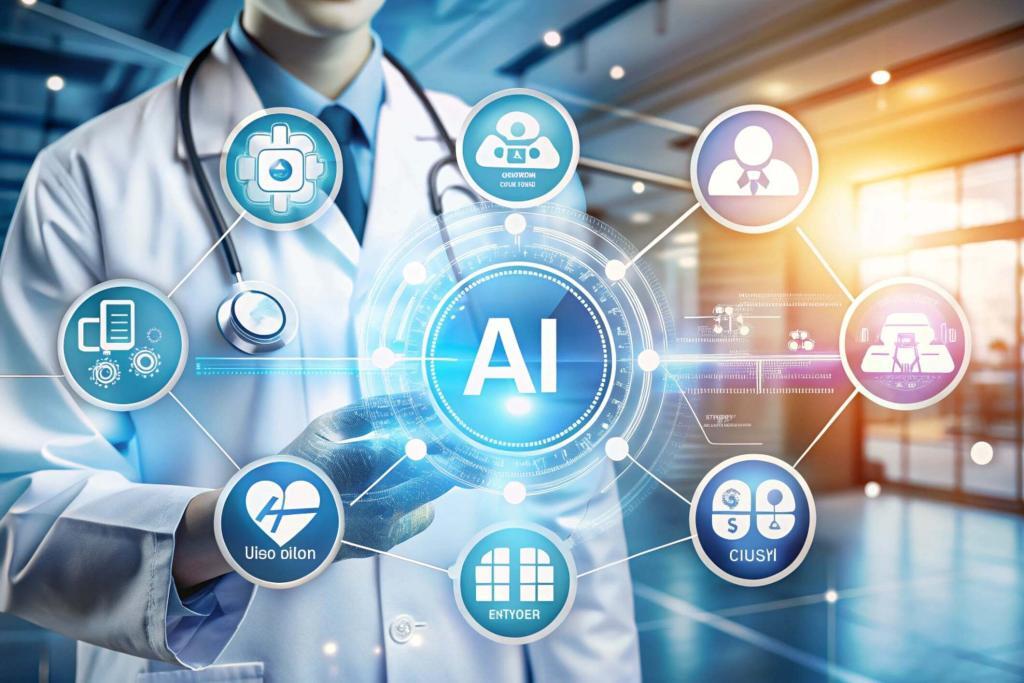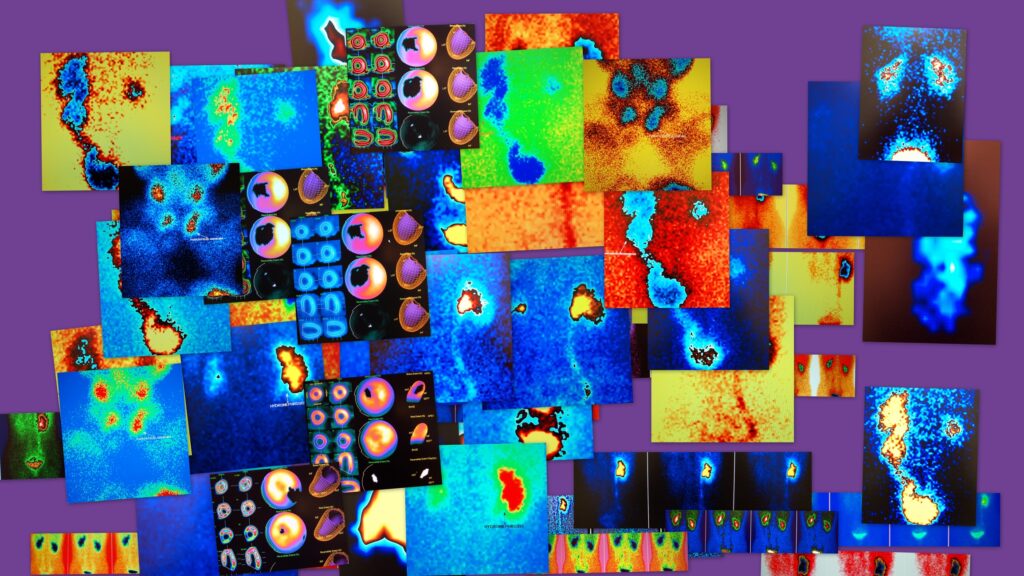Summary
Artificial Intelligence (AI) has emerged as a transformative force in numerous domains, including healthcare and medical imaging. In Magnetic Resonance (MR), AI is revolutionising the ways images are acquired, processed, analysed, and interpreted. This article explores the integration of AI in MR technology, detailing advancements in imaging acquisition, data reconstruction, diagnostic assistance, and research. Additionally, it examines challenges such as ethical considerations, data privacy, and the need for interdisciplinary collaboration to unlock the full potential of AI in MR.
Introduction to AI in Magnetic Resonance
Magnetic Resonance (MR), encompassing both Magnetic Resonance Imaging (MRI) and Magnetic Resonance Spectroscopy (MRS), is a cornerstone of modern medical diagnostics and research. It provides detailed insights into anatomical structures, physiological processes, and biochemical compositions without invasive procedures.
However, traditional MR techniques face challenges, including long acquisition times, high costs, and complex data interpretation. AI has stepped in as a powerful ally, offering tools to optimise MR workflows, enhance diagnostic accuracy, and expand research possibilities.
A Brief Overview of AI
AI refers to computational systems designed to mimic human intelligence, including learning, reasoning, and problem-solving. In MR, AI algorithms, particularly those based on machine learning and deep learning, are applied to improve image acquisition, processing, and analysis. These methods enable automated pattern recognition, data reconstruction, and even predictive analytics.
Enhancing Image Acquisition in MR
One of the most significant applications of AI in MR is improving the efficiency and quality of image acquisition. AI-powered systems address challenges such as motion artefacts, time constraints, and suboptimal imaging parameters.
Faster Imaging with AI
Traditional MR scans are often time-intensive, leading to patient discomfort and higher operational costs. AI-driven techniques, such as compressed sensing and deep learning-based reconstruction, allow for faster acquisition while maintaining or even enhancing image quality.
For example:
- Parallel imaging with AI: Neural networks predict missing k-space data, enabling rapid acquisition.
- Motion correction algorithms: AI identifies and compensates for patient movement during scans, reducing the need for repeats.
Adaptive Scanning
AI-enabled MR systems dynamically adjust imaging parameters in real time based on patient-specific factors. For instance, AI can tailor protocols for paediatric or claustrophobic patients to minimise scanning time and improve comfort without sacrificing diagnostic value.
Revolutionising Image Reconstruction
Image reconstruction translates raw MR data into interpretable images. Traditional reconstruction methods can be computationally demanding and time-consuming, with limitations in resolution and signal-to-noise ratio. AI has made significant strides in this area, enabling faster and more accurate reconstructions.
Deep Learning for Image Reconstruction
Deep learning models, such as convolutional neural networks (CNNs), are used to reconstruct MR images directly from raw k-space data. These models outperform conventional algorithms by producing high-quality images with fewer artefacts.
Examples include:
- Deep Cascade Networks: These networks iteratively refine images to improve clarity and diagnostic accuracy.
- Generative Adversarial Networks (GANs): GANs enhance image quality by generating realistic textures and details that may be lost in traditional reconstructions.
Low-Field Imaging Applications
AI is also transforming low-field MR imaging. Traditionally, low-field systems offer reduced image quality compared to high-field counterparts. AI compensates for these limitations by boosting resolution and noise suppression, making low-field systems more accessible and cost-effective for resource-constrained settings.
Diagnostic Assistance: The Role of AI in Clinical Decision-Making
AI systems are proving invaluable in assisting radiologists and clinicians in diagnosing diseases, especially in complex or ambiguous cases. By analysing MR images, AI models can identify subtle patterns, classify abnormalities, and predict disease progression.
Disease Detection and Classification
AI algorithms are being trained to detect and classify various conditions, including:
- Neurological Disorders: AI aids in identifying early signs of Alzheimer’s disease, multiple sclerosis, and brain tumours by analysing structural and functional MR data.
- Cardiovascular Diseases: MR imaging of the heart, enhanced by AI, supports the diagnosis of myocardial infarctions, cardiomyopathies, and congenital heart defects.
- Oncology: AI improves tumour detection and segmentation in MR images, aiding treatment planning and monitoring.
Quantitative Analysis
AI automates the extraction of quantitative metrics from MR data, such as brain volumetrics, tissue perfusion, and metabolic rates. These measurements provide objective markers for disease progression and treatment response.
Reducing Diagnostic Errors
By offering a second opinion or pre-screening images for anomalies, AI systems reduce the likelihood of human error. This is particularly crucial in high-stress environments or when dealing with complex cases.
Expanding Research Frontiers
AI is not only enhancing clinical workflows but also pushing the boundaries of MR research. By enabling advanced data analysis and hypothesis testing, AI is driving discoveries in neuroscience, oncology, and personalised medicine.
Functional MRI (fMRI) and AI
Functional MRI studies brain activity by measuring changes in blood oxygenation. AI enhances fMRI research by:
- Improving spatial and temporal resolution.
- Detecting subtle connectivity patterns in neural networks.
- Supporting large-scale meta-analyses through automated data processing.
Magnetic Resonance Spectroscopy (MRS)
MRS provides biochemical information about tissues, often used in cancer and neurological research. AI accelerates MRS analysis by automating spectral fitting, improving metabolite quantification, and uncovering patterns indicative of disease.
Drug Discovery and Development
AI-assisted MR techniques support pharmaceutical research by:
- Screening drug candidates based on molecular imaging.
- Monitoring drug efficacy and toxicity in vivo.
- Supporting biomarker discovery for targeted therapies.
Challenges and Ethical Considerations
While AI holds immense potential in MR, several challenges must be addressed to ensure its safe and effective integration.
Data Quality and Standardisation
AI models require large, high-quality datasets for training. Variability in imaging protocols, scanner types, and patient populations can lead to biases in AI performance. Developing standardised datasets and protocols is critical.
Data Privacy and Security
Given the sensitive nature of medical imaging data, ensuring patient confidentiality is paramount. Robust encryption and data anonymisation techniques must accompany AI deployment.
Regulatory and Ethical Issues
AI in MR raises ethical questions, such as:
- Accountability in AI-assisted diagnoses.
- Transparency in AI decision-making.
- Mitigating biases that could lead to unequal access or care.
The Role of Radiologists
There is ongoing debate about whether AI will replace radiologists. Most experts agree that AI should be viewed as an augmentation tool, enhancing human expertise rather than replacing it. Radiologists will need to adapt by acquiring skills in AI literacy and integration.
The Future of AI in Magnetic Resonance
The journey of AI in MR is just beginning. Future advancements are likely to focus on:
- Real-time Imaging: AI will enable near-instant image acquisition and analysis, facilitating point-of-care diagnostics.
- Integration with Other Modalities: Combining MR data with inputs from CT, PET, or genomic information will offer a more holistic understanding of health and disease.
- Personalised Medicine: AI-powered MR imaging will support tailored diagnostics and treatment plans, improving patient outcomes.
Collaboration between radiologists, engineers, data scientists, and policymakers will be crucial in shaping the future of AI in MR. Investment in education, infrastructure, and ethical frameworks will also be essential to realise AI’s full potential.
Conclusion
AI is revolutionising Magnetic Resonance by improving imaging efficiency, diagnostic accuracy, and research capabilities. It is reducing barriers to access, enhancing patient care, and paving the way for personalised medicine. However, the integration of AI into MR must be approached thoughtfully, addressing challenges such as data privacy, bias, and ethical concerns.
The future of AI in MR is promising, with the potential to transform medical imaging and redefine the standards of care. By embracing interdisciplinary collaboration and innovation, the field can unlock unprecedented opportunities for clinicians, researchers, and patients.
Disclaimer
The content of this article, Transforming Magnetic Resonance: The Power of Artificial Intelligence, is provided for informational and educational purposes only. While every effort has been made to ensure the accuracy and relevance of the information at the time of publication (27 November 2024), Open Medscience does not guarantee its completeness or ongoing validity.
This article does not constitute medical advice, diagnosis, or treatment and should not be relied upon as such. Readers are encouraged to consult qualified medical professionals or specialists for advice regarding specific medical conditions or the application of Artificial Intelligence (AI) in clinical settings.
The views expressed are those of the authors and do not necessarily reflect the official policy or position of any affiliated institutions or organisations. Any mention of commercial products, technologies, or companies does not imply endorsement by Open Medscience.
AI in medical imaging, including Magnetic Resonance (MR), is a rapidly evolving field. Readers should be aware of ongoing developments, regulatory guidance, and ethical considerations that may impact the implementation or interpretation of AI-assisted techniques.
Open Medscience is not liable for any decision or action taken based on the content of this article. Use of this information is at the reader’s own risk.
You are here: home » diagnostic medical imaging blog »



